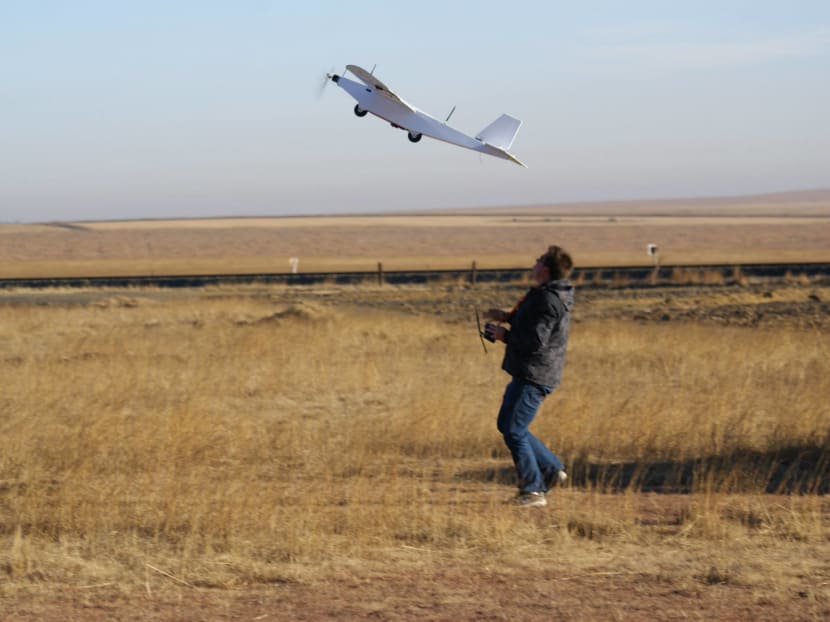UK group uses drones to monitor rare birds
LONDON — Military technology used to track down insurgents in Afghanistan has been adopted by Britain’s biggest nature conservation charity to protect some of the country’s rarest birds.

A ShadowView Foundation employee testing one of its drones for best landing methods in
tough terrain.
LONDON — Military technology used to track down insurgents in Afghanistan has been adopted by Britain’s biggest nature conservation charity to protect some of the country’s rarest birds.
The Royal Society for the Protection of Birds (RSPB) is using a remotely controlled drone to spy on the nests of endangered breeds and monitor the progress of reintroduced species, as the use of unmanned aerial vehicles (UAVs) becomes increasingly common outside combat zones.
The RSPB drone was created by Mr Nigel Butcher, the charity’s answer to James Bond’s gadget inventor Q, at its new Centre for Conservation Science in Sandy, Bedfordshire.
“A lot of our stuff filters down from military use,” Mr Butcher said. “We built the ’copter about a year ago and have added bits and pieces to it since, like radio tracking, thermal imaging and wide-angle cameras.”
Breeding patterns of bitterns and marsh harriers can be seen without disturbing precious habitat, and the RSPB is also using the drone to monitor how cranes and corncrakes are faring as they are reintroduced to the United Kingdom. It also plans to reach inaccessible nests over wetlands for the BBC Spring Watch series at the Minsmere reserve on the Suffolk coast.
“In the case of a marsh harrier, we might want to use it to check on the state of a nest without traipsing in,” Mr Butcher said. “We don’t like to put cameras close to nests until the eggs have hatched, because the birds can be prone to deserting the nest.
“But with the drone, you can scoot it round to confirm the state of the nest. The alternative is having eight or 10 people trampling through a reed bed in knee-high waders causing a lot of disturbance.”
The main advantage of the craft is how quiet it is. “It only has six little electric motors, so it is almost drowned out by ambient sound and the wind, and doesn’t disturb the birds,” Mr Butcher added.
The thermal imaging camera can track birds and mammals at night, when many species are most active. And like a combat drone, the RSPB’s model can be piloted remotely using a live-video feed.
Despite its benign purpose, the RSPB project and the growing use of drones for international conservation projects have prompted alarm about privacy.
Mr Chris Sandbrook, a lecturer in conservation leadership at Cambridge University, said: “What the RSPB is doing with drones sounds like a good thing, and I’m sure it will be accompanying it with some sensible messaging to reassure the public that there aren’t Al Qaeda operatives hiding in reed beds,” he said.
“But if you lived next to an RSPB reserve and saw one of these things flying around at the end of your garden and didn’t know why it was there, you might be a bit worried.”
Mr Sandbrook is more concerned about the use of drones in international conservation projects, such as the one to protect mountain gorillas in Uganda. He said that if drones are used on such projects, they could undermine years of work to build up the support and trust of local people.
“Drones might be a great way of collecting data or even cracking down on poaching, but they might make people feel spied upon and disenfranchised. In these kinds of places, if local people don’t believe in the conservation project, it really can’t work.”
“It is one thing to look at a corncrake nest; it’s quite another if you are taking images of people and their behaviour,” he said.
With the cost of UAVs dropping, drones are becoming an affordable conservation tool in the fight against poachers and to protect endangered species such as the elephant and rhino.
The recently established ShadowView Foundation, which provides drones for conservation and humanitarian relief operations, has installed systems in South African game parks in Uganda, Tanzania and other locations vulnerable to illegal wildlife trade.
In Namibia, the World Wildlife Fund (WWF) has a Wildlife Crime Technology Project with an “eyes in the sky” surveillance project to fight poachers and regards the drones as a key tool in its arsenal. The WWF has also introduced drones in Nepal’s national parks, home to endangered rhinos, tigers and elephants.
“As the global poaching crisis escalates, WWF is excited by the potential of technologies such as UAVs to aid rangers on the front line and better protect Nepal’s natural heritage,” said Mr Shubash Lohani, deputy director of WWF’s Eastern Himalayas programme, as the first drones were introduced. THE GUARDIAN





